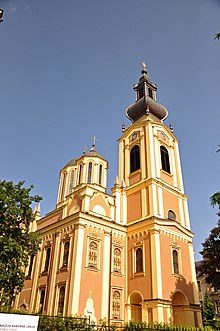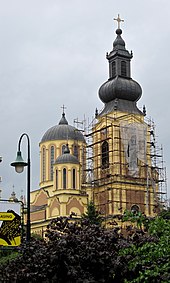Cathedral of the Nativity of the Virgin Mary (Sarajevo)
The Serbian Orthodox Cathedral in Sarajevo , and Church of the Nativity of the Most Holy Mother of God ( Serbo-Croatian : Саборна Црква Рођења Пресвете Богородице, Saborna Crkva Rođenja Presvete Bogorodice) in Sarajevo , capital of Bosnia and Herzegovina , is one of the largest Orthodox churches on the Balkan Peninsula .
It is the cathedral of the Metropolitan Dabrobosnia of the Serbian Orthodox Church . The Cathedral of the Birth of the Virgin Mary is located in the city center of Sarajevo, not far from the Roman Catholic Sacred Heart Cathedral . It was built from 1859 to 1874. The cathedral is dedicated to the birth of the Most Holy Mother of God, Mary , the mother of Jesus .
history
construction
The decision to build the Serbian Orthodox Cathedral of the Nativity in Sarajevo was made at the beginning of 1859 when the great European powers Great Britain , France and Russia put increasing pressure on the Ottoman Empire to grant its Christian citizens religious freedom. This included the building of churches. The peace of Paris of 1856 created the conditions for the construction of the cathedral, as the Ottoman Empire complied with the demands of the great European powers and put Muslims and Christians on an equal footing.
This equality made it possible to build new churches, renew the old churches and reopen Christian schools. During this period, shortly before the end of the centuries-long Ottoman rule in south-eastern Europe , a large number of Serbian Orthodox cathedrals were built, often in the center of the respective city, and thus became the bishops' seats of the Serbian Orthodox Church. These include: the Serbian Orthodox Cathedral of St. Archangel Michael in Belgrade (1837–1845), the Serbian Orthodox Cathedral of St. Great Martyr George in Novi Sad (late 19th century), the Serbian Orthodox Church of St. Great Martyr George in Smederevo (1850-1854), the Serbian Orthodox Trinity Cathedral in Niš (1856-1872), the Serbian Orthodox Cathedral of St. Vasilije Ostroški in Nikšić (1875-1880), the Serbian Orthodox Trinity Cathedral in Mostar (1863-1873) and the Serbian Orthodox Cathedral of the Birth of the Virgin in Sarajevo (1859–1874).
From 1859 to 1862 the building material was collected and the building land on the right bank of the Miljacka was bought. In 1863 construction began with the approval of the Ottoman sultan. On June 11, 1864, the foundation of the cathedral was blessed. The construction of the cathedral took a total of eleven years, on May 1, 1874 the cathedral was completed. The cathedral was inaugurated on July 20, 1874 by Metropolitan Pajsije .
The financing of the cathedral, from the start of construction in 1863 to completion, was largely raised by donations from the Orthodox citizens of Sarajevo and the surrounding villages. But the people of Belgrade also donated money for the construction, including the Serbian Prince Mihajlo Obrenović . Serbian Orthodox traders from Dubrovnik , Vienna and Trieste also donate money for the construction of the cathedral. Metropolitan Sava Kosanović also donated money when he was in Russia. Even the Sultan Abdülaziz donated money to build the cathedral. Andrej Damjanov from Veles , who also built the Orthodox Trinity Cathedral in Mostar, was hired as the builder .
In the first World War
Only one day after the assassination attempt in Sarajevo on June 29, 1914, anti-Serb demonstrations broke out in Sarajevo. During these demonstrations, the Serbian Orthodox seminary building and the metropolitan headquarters were damaged before the demonstrators moved to the Orthodox cathedral. During the First World War , the lead roof of the cathedral and the church bells were removed by the Austrians. Instead of the lead roof, the cathedral was covered with an inferior brass roof, which contributed significantly to the fact that the cathedral fell into disrepair during the First World War. The renovation work on the outside and inside of the cathedral that took place after the war lasted until May 1921. In the course of this renovation, the cathedral was given a copper roof. The interior was renewed with oil paints and it got a new floor. The cathedral was also connected to the electricity network. The iconostasis was also gilded. In addition, three bells were bought in Trieste . The heaviest of these weighed 2800 kg, the middle one 1600 kg and the smallest bell 750 kg. Overall, the total renovation was completed by Christmas 1922, so that the cathedral was consecrated again for Christmas 1922 and the first Holy Liturgy could take place.
In World War II
A few days after the German Reich invaded the Kingdom of Yugoslavia on April 6, 1941, the Wehrmacht and Ustascha occupied the city of Sarajevo. In May 1941 the Ustaša and the Roman Catholic priest Božidar Brale forbade the use of the Cyrillic script in Sarajevo. On May 12, the Metropolitan of Sarajevo Petar Zimonjić was arrested by members of the Ustasha in the metropolitan seat and transferred to Zagreb a few days later . It has never been confirmed whether Metropolitan Zimonjić was killed in Jasenovac or Jadovno concentration camps in 1941 . The Ustaše banned the Serbian Orthodox Church, and all clergymen they could get hold of were taken to concentration camps, where most of them were murdered. Few Orthodox priests in Sarajevo survived World War II. The Cathedral of the Birth of the Virgin suffered severe damage and had to be renovated after the war.
In the Bosnian War 1992 to 1995
The Orthodox Cathedral of the Nativity was badly damaged during the Bosnian War and the Siege of Sarajevo . Services did not take place from 1992 to 1996. The metropolitan seat, which is not far from the cathedral, was bombed and robbed in 1992. In the same year, part of the building burned down, including the historically valuable library and the historical archive. During the war, a large part of the Orthodox Serb population fled Sarajevo and came back to areas that had previously been "ethnically cleansed" by Bosnian Serbs ' troops .
Renovation of the cathedral after 1996
After the end of the Bosnian War and the siege of Sarajevo in 1996, the cathedral was renovated both outside and inside. After the war, the Orthodox seminary was converted into a business school. The Serbian Orthodox Church tried several times to get the building back, but to no avail.
During the armed conflict, Metropolitan Nikolaj temporarily relocated his seat from Sarajevo to the Republika Srpska , the Serbian part of Bosnia and Herzegovina. The small town of Sokolac was chosen so that the Orthodox Church of St. Elias in Sokolac briefly became the cathedral church of the Orthodox eparchy . The Orthodox population of Sarajevo demanded that the Cathedral of the Nativity of the Virgin Mary once again become the episcopal church of the eparchy. After some time of stable peace, Metropolitan Nikolaj moved the eparchy seat back again. All major ecclesiastical festivals, including the Holy Liturgies for Christmas and Easter, were celebrated again in the cathedral.
architecture
The cathedral is a three-aisled basilica with the five domes on the roof, typical of Orthodox church buildings, which represent Christ and the four evangelists. The floor plan forms an elongated Greek cross. The cathedral was built of stone, the roof covered with lead. The cathedral has six doors. The floor consists of marble slabs . The altar and its anteroom are built in three levels.
The icons on the iconostasis were gilded, Metropolitan Sava Kosanović brought these icons from Russia in 1873 . There are wooden benches for the old and the weak along the walls. The metropolitan throne is on the right column, to the left of which is the gilded altar table. Behind the altar table rises a gilded pulpit on which lies a golden book from which the priest preaches the Gospel . Also there is the place of the golden chalice . The cathedral has eight domes, five large ones - one each for Christ and the four evangelists - and three small domes as a symbol of the Trinity stand above the altar.
There are two rows of windows along the walls. The cathedral is 37 meters long and 22.50 meters wide. The height of the walls is 15.5 meters, that of the main dome 34 meters and that of the secondary domes 20 meters. The church tower, built in the baroque style, is 45 m high. The cathedral was the subject of many paintings by various artists, including the Serbian artist Paja Jovanović .
The cathedral choir
The Serbian Orthodox church choir has been singing "Sloga" (German: unity) in the Orthodox Cathedral in Sarajevo since 1888. The church choir emerged from the Orthodox population of Sarajevo, it mainly consisted of craftsmen under the direction of Risto Maksimović , the archpriest Sijepo Trifković and archpriest Đorđe Petrović , who was a member of the orthodox singers' association "Sloga".
The church choir was active until 1992 when the signs of war in Bosnia indicated. Because of an illness of the conductor Branko Glumac , he left the church choir in 1993 and his sister, the music professor Branka Bošnjak , took over the choir direction. All Orthodox churches in Sarajevo were closed during the war, except for the old Orthodox church in historic Baščaršija, where the Sarajevo's church choir was able to meet thanks to the organization by Archpriest Krstan Bijeljac .
Today the church choir is led by deacon Duško Sandić , who is a professor of church music. The choir has 40 active members who sing in the cathedral and all other Orthodox churches in Sarajevo and its surroundings.
gallery
Web links
swell
- Црна књига - Патње Срба Босне и Херцеговине за време светског рата 1914-1918. године / Владимир Ћоровић , Издавач: Удружење ратних добровољаца 1912-1918. Trebinje, Belgrade (1996)
- Духовни геноцид: Преглед порушених, оштећених и обесвећених цркава, манастира и других и других цр5авених кр599 (Serbian) 1 калатут 1991
- Пројекат Растко: Усташки злочини над србским свештеницима - Велибор В. Џомић (Serbian)
- Саборна црква у Сарајеву (Serbian)
- Архијерејско намјесништво сарајевско: Саборна црква Рождества Пресвете Богородице у Сарајеву (Serbian)
- Сарајевска богословија (Serbian)
Coordinates: 43 ° 51 ′ 29.5 " N , 18 ° 25 ′ 30.4" E









